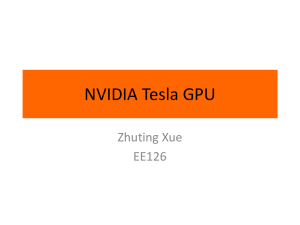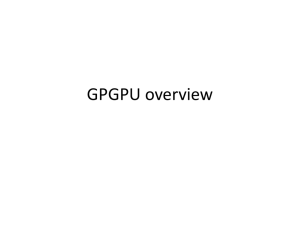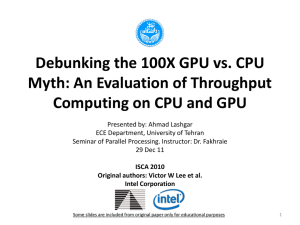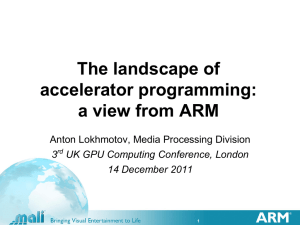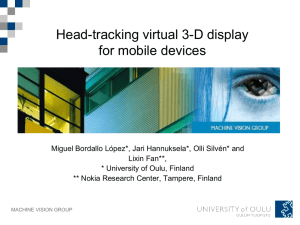GPU-accelerated image recognition
advertisement
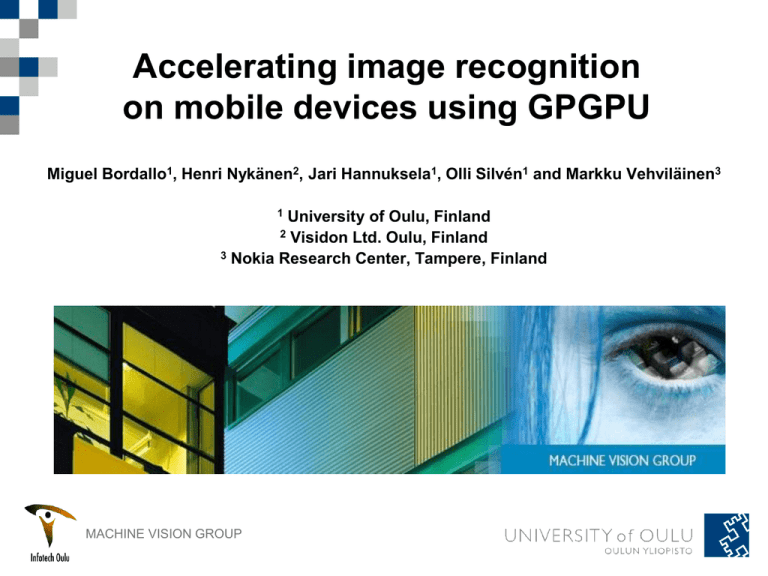
Accelerating image recognition on mobile devices using GPGPU Miguel Bordallo1, Henri Nykänen2, Jari Hannuksela1, Olli Silvén1 and Markku Vehviläinen3 1 University of Oulu, Finland 2 Visidon Ltd. Oulu, Finland 3 Nokia Research Center, Tampere, Finland Jari Hannuksela, Olli Silvén Machine Vision Group, Infotech Oulu Department of Electrical and Information Engineeering University of Oulu, Finland MACHINE VISION GROUP Contents Introduction Mobile Image Recognition • Local Binary Pattern Graphics processor as a computing engine GPU accelerated image recognition • LBP Fragment Shader implementation • Image preprocessing Experiments and results • Speed • Power Consumptions MACHINE VISION GROUP Motivation • Face detection and recognition is a key component of future multimodal user interfaces • Mobile computation power still not harnessed properly for real-time computer vision • High demand computations compromise battery life. • Need for energy and computationally efficient solutions MACHINE VISION GROUP Face analysis using local binary patterns • Face analysis is one of the major challenges in computer vision • LBP method has already been adopted by many leading scientists • Excellent results in face recognition and authentication, face detection, facial expression recognition, gender classification MACHINE VISION GROUP Local Binary Pattern MACHINE VISION GROUP GPU as a computing engine GPU can be treated a an independent entity • Newer phones include a GPU chipset • OpenGL ES as a highly optimized and attractive accelerator interface • Emerging platforms (OpenCL EP) will facilitate using the GPU as a computing resource • Compatible data formats for graphics and camera subsystems desirable MACHINE VISION GROUP Fixed pipeline (OpenGL ES 1.1) vs. programmable pipeline (OpenGL ES 2.0) MACHINE VISION GROUP Stream processing (OpenGL) vs. shared memory processing (CUDA) MACHINE VISION GROUP OpenCL (Embedded Profile) • • • • Emerging platforms will offer needed flexibility OpenCL Embedded Profile is a subset of OpenCL Supports data and task parallel programming models Code executed concurrently on CPU & GPU (& DSP) – Other current and future resources are compatible – Easier programming in a heterogeneous processor environment • High parallelization on image processing computations -> High efficiency MACHINE VISION GROUP GPU assisted face analysis process MACHINE VISION GROUP GPU-accelerated image recognition • Open GL ES 2.0: – Image features (LBP,...) extraction: – Image preprocessing – Image scaling – Displaying • C code: – Camera control – Classification MACHINE VISION GROUP • c LBP fragment shader implementation • Two versions: – Version 1: calculates LBP map in one grayscale channel – Version 2: calculates 4 LBP maps in RGBA channels •Access the image via texture lookup •Fetch the selected picture pixel •Fetch the neighbours values •Compute binary vector •Multiply by weighting factor MACHINE VISION GROUP Preprocessing Create quad Render each piece in one channel Divide texture & Convert to grayscale MACHINE VISION GROUP Experiments setup • OMAP 3 family (OMAP3530) – ARM Cortex A8 CPU – Power VRSGX535 GPU • 3 set-ups: – Beagleboard revision 3 – Zoom AM3517EVM (TI Sitara) – Nokia N900 MACHINE VISION GROUP Processing times: LBP extraction Size GPUv1 GPUv2 CPU CPU& GPUv1 CPU& GPUv2 1024x1024 232ms 180ms 100ms 116ms 90ms 512x512 76ms 46ms 25ms 37ms 23ms 64x64 2ms 1,5ms 0,4ms 1ms 0,2ms •Computing LBP in four channels (version 2) faster than computing in one •CPU faster than GPU •Concurrent execution of algorithms in GPU + CPU increases performance MACHINE VISION GROUP Processing times: Preprocessing Size GPU CPU CPU &GPU 1024x1024 35ms 100ms 54ms 512x512 10ms 25ms 15ms 64x64 0,2ms 0,4ms 0,4ms •GPU outperforms CPU in pixelwise simple operations (scaling + interpolation) •Concurrent execution of algorithms in GPU + CPU slower than GPU alone due to data transfers MACHINE VISION GROUP Speed (II): Preprocessing Size GPU CPU CPU&GPU 1024x1024 35ms 100ms 54ms 512x512 10ms 25ms 15ms 64x64 0,2ms 0,4ms 0,4ms MACHINE VISION GROUP Speed (II): Preprocessing Size GPU CPU GPU preprocessing & CPU LBP extraction 1024x1024 215ms 205ms 142ms 512x512 56ms 50ms 40ms 64x64 1,8ms 1ms 0,8ms MACHINE VISION GROUP Power and Energy consumptions Operation GPU CPU Preprocesing 27mJ 19mJ LBP 5,3mJ 10mJ Combined algorithm 32,3mJ 28mJ •Power consumption of GPU and CPU is independent •CPU – 190mW •GPU – 110mW-130mW (increases with image size) •Energy consumption depends on processing time •GPU has smaller energy per operation. MACHINE VISION GROUP Summary •GPUs can be used as a general purpose procesors •New platforms will offer more efficiency and flexibility •Not optimized interfaces include excesive overheads MACHINE VISION GROUP Future directions • • • • Implementation of classifier Implementations in OpenCL Multi-scale LBP Implementation of other feature extraction MACHINE VISION GROUP Thank you! • Any questions??? Thanks to Texas Instruments for the donation of the Hardware MACHINE VISION GROUP

